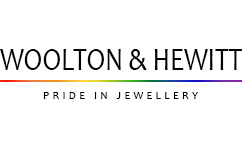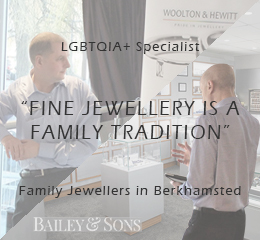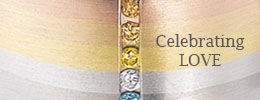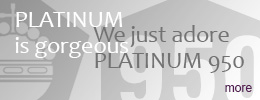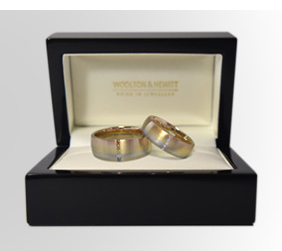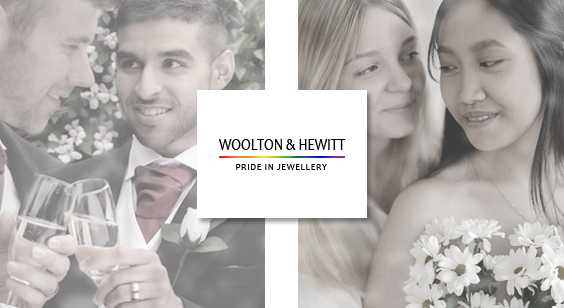 Types of Precious Metals
Types of Precious Metals
Precious metals are special. Over millennia they have been prized
for their rarity and beauty. They can be worked into complex and
stunning forms and, with an intrinsically high lustre, when
polished appear magically silky.
WOOLTON & HEWITT engagement rings and wedding rings are made
in a range of grades and colours of GOLD, in PALLADIUM and, using
the ultimate precious metal of all, PLATINUM. Let's look at them
individually.

Gold is graded in carats (ct or k) with
24 carats representing pure gold. The grades or qualities of gold
that we use are:
9ct is 37.5% gold | 14ct is 58.5% gold |
18ct is 75% gold | 22ct is 91.6% gold
We work with gold in six colours: yellow, white, rose, champagne,
hint-of-hazel and hint-of-ivory. White gold is created by alloying
gold with silver, palladium and small amounts of other metals. The
redder colours are formed from gold mixed with copper. The colour
of champagne gold is between rose and yellow gold, and is similar
to the hues associated with Victorian jewellery. Hint-of-hazel
gold is like white gold with a slight brown tint. Similarly,
hint-of-ivory gold is a version of white gold with a slight yellow
hue. White gold is not completely white in colour so may be
rhodium plated to give it a really white finish. Over time this
plating will inevitably wear away and the underlying colour of the
gold alloy will show. Re-plating is possible or you may prefer to
live with the patina of age.

Platinum is an extremely rare noble
metal and gives it's name to the Platinum Group Metals. It has a
lustrous shiny silvery-white colour, extremely high density and is
resistant to corrosion. It has the highest melting point of all
the precious metals and is the most expensive. UK assay offices
recognise four levels of fineness for Platinum: 850, 900, 950 and
999. That's parts per thousand. In our rings we only use the
highest jewellery grade, that's platinum 950. It's the best so we
love platinum 950.

Palladium is a rare and silvery-white
precious metal that resembles platinum and forms part of the
Platinum Group Metals (platinum, rhodium, ruthenium, iridium and
osmium). It has been used for some time in various types of
jewellery and wedding rings. Its popularity increased in the 21st
century and, from the 1st January 2010, hallmarking
palladium became a legal requirement. Recognised fineness
standards are: 500, 950 and 999. That's parts per thousand.
Palladium is less dense than platinum so a palladium wedding ring
feels lighter than 18ct gold or platinum 950. As a special order
we can make your wedding rings and engagement rings in palladium
950.
Note: Colours on screen vary enormously - the
colours shown on this website, and in any other photographs and
images we may provide, are indicative only.
 Allergies
Allergies
Although rare, it is possible to be allergic to metals. Precious
metals are actually alloys combining various types of metal so if
you are, or suspect you may be, allergic to any type of metal
please contact us before
ordering your rings.
 Quality Assurance
Quality Assurance
In accordance with UK law WOOLTON & HEWITT wedding rings,
engagement rings, and wedding jewellery are hallmarked
by an independent assay office to indicate the grade or fineness
of the precious metal. For example, 9ct gold which contains 37.5%
gold is marked "375", 18ct gold being 75% gold shows "750", and
platinum at 95% purity is given a "950" mark. This testing of the
precious metal and making of its fineness is your QUALITY
ASSURANCE.
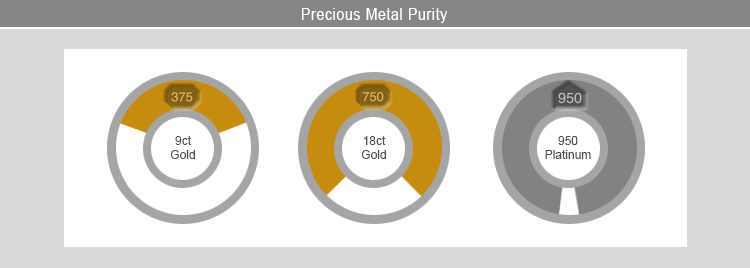
 Durability
Durability
Precious metals are softer than steel and ceramics. Your hand, and
therefore your wedding ring, will continually come into contact
with hard metal objects like door and cupboard handles, taps,
coins and keys. Inevitably your rings will quickly show scratches,
dents and marks as a result of this normal everyday use. In
contrast to the perfect finish of the rings when new you may find
these marks disconcerting. However, as they accumulate they will
blend into one another and create a patina that reflects the
passage of time. To illustrate this, the first pair of photographs
below shows marking of a matte finished wedding ring in 18ct rose
gold and palladium 950; the second shows scratches across platinum
950 and 18ct gold.

The properties of precious metals do vary but, as we've
explained, in practical terms all of them will quickly become
scratched and dented through normal use. However, you may be
interested in the various ways to measure hardness which, to add
to the complexity, also depends on the precise type of alloy and
how it has been worked. The Vickers Test measures resistance to
indentation and is shown in HV units.
The Mohs Scale reflects the ability of the surface of a substance
to resist scratching.
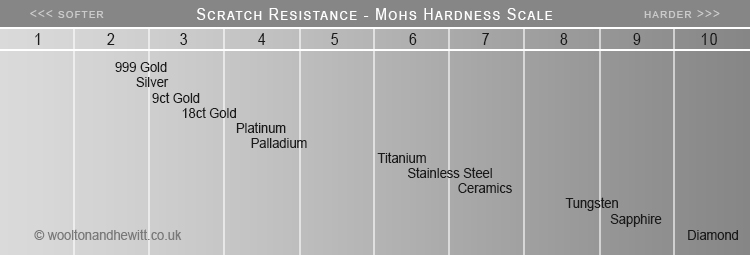
 Brushed Finish vs Polished
Brushed Finish vs Polished
In the first few days of wear, when your rings are brand new, a
brushed finish will accentuate marks more than polished. This for
a couple of reasons. First because the eye notices the disruptions
that marks make in the otherwise regular brushed pattern. It's
also because the marks tend to be brighter (or sometimes darker)
than the brushed finish.
In contrast, the initial marks in a high polished ring tend to be
disguised by the brightness of the reflections. Of course the
marks are still there and they are visible to the eye, you just
have to look a little harder to see all of them.
As marks accumulate over a few weeks of use, for both brushed and
polished finishes, they will become clearly noticeable. If you
focus on them at this point they can be worrisome. However, this
is actually just normal wear and tear for all precious metals
exposed to the everyday environment.
After about 6 to 12 months your rings will have integrated all the
various marks, scratches and dings into a patina that reflects
their "lived-in" status. At this point it can be quite hard to
tell which ring started out as brushed and which as polished!
In the end, a brushed ring becomes marked and develops a partial
polish in some areas as a result of rubbing. And a polished ring
becomes similarly marked but looses it shine due to the
accumulation of a myriad of tiny scratches. Although they start
out looking quite different they move towards appearing quite
similar. Finally, after about 2 years your rings will have taken
on their "mature" appearance gracefully ageing as you journey
through life together.
 Care
Care
For care and cleaning guidance for your engagement rings and
wedding rings please click
here.
 Diamond Quality
Diamond Quality
What you need to know about diamonds is usually referred to as the
4 C’s: Cut, Clarity, Colour, Carat.
Cut is the way that the rough diamond
has been shaped into a gemstone. The most usual cut is the "modern
brilliant" which, with 58 facets, maximises the diamond's sparkle.
Fancy cuts which include pear shape, marquise, emerald cut and
princess cut, can be very attractive alternatives.
Clarity is a way to describe marks and
flaws within a diamond. Tiny, so called "inclusions", are small
pieces of black carbon or other minerals located inside the
diamond. External blemishes, those on the surface of the stone,
are also incorporated into the Clarity score of a diamond.
Diamonds are formally graded according to the following scale:

As standard our round diamonds are either graded SI or VS,
depending on the particular ring design. This means that to the
untrained naked eye nothing will be seen within the stone.
However, upon request, we can provide a quotation to upgrade to
even greater clarity.
Colour is extremely important. A pure
white or colourless diamond is the best. However, diamonds come in
many shades of colour and this determines the price. Diamond
colour is graded from D to Z with D being colourless (the very
best) and Z representing a yellowish colour. The standard set by
the Gemological Institute of America (GIA) describes the grade
ranges as follows:
All of our diamonds are at the very top end of this scale being H
or even better depending on the particular ring design.
Carat is the weight of the diamond: 1
carat = 0.2 grams. You should not confuse the carat weight of
diamonds with the carat used for the purity of gold.
 Shapes & Finishes
Shapes & Finishes
Wedding rings are made in a number of cross-sectional profiles.
Some of the more usual ones are shown below.
"D" - Flat inner surface rising to a dome on the outside
Court - Gentle curved inner and outer faces; the inner court is
often referred to as "comfort fit"
Flat Court - combines the comfort of the inner curve with a flat
outer profile
"D" Court Flat - combines the comfort of the inner curve with the
depth of the dome and a flat outer face
Flat - flat surfaces on both the inner and outer faces
A range of finishes is also used to style wedding rings, usually
only on the outer face. These include: highly polished, matte,
sandblasted, bark effect and hammered.
 Ring Size Measurement
Ring Size Measurement
Getting the right ring size is really important. Paper, card and
tape ring sizers will give you an approximate size. But for
accuracy we recommend use of professional ring sizers. This is a
set of metal rings in standard and wide widths. These sizers
emulate your wedding ring and will give you confidence in the size
that you need. For accuracy and convenience we can loan you a
partial set of ring sizers (the sizes around your estimated ring
size) for use at home. For more details please review our Ring
Sizers page.

